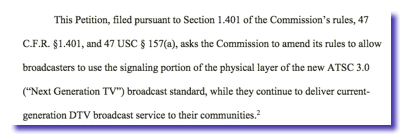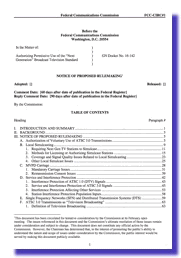FCC-CIRC#1
A New Procedure for FCC:
ATSC 3.0 Issues
Now this can be resolved simply by specifying a vaguely transparent mechanism for giving feedback on these drafts, whether it is ECFS or a more informal system. Should there be some "paper trail" of what the feedback was or who gave feedback?
But here are my views on FCC CIRC #1, shown above. This is a draft NPRM "Authorizing Permissive Use of the 'Next Generation' Broadcast Television Standard" called ATSC 3.0. Readers of this blog know that there is no greater supporter of Section 7 of the Communications Act which deals with new technology. Thus it is amusing to note that even though NAB explicitly raised the issue of Section 7 on p. 1 of its petition:

that he draft NPRM actually never mentions the Section 7! Did the FCC staff that drafted it not notice that Chmn. Pai's very first speech as a commissioner dealt explicitly with the Commissioner's failure to use this law signed by Pres. Reagan 30+ years ago? In that speech, then Comm. Pai said:

So since NAB raised it, why doesn't the NPRM deal with the Section 7 issue?
(Perhaps NAB is "entitled" as a "professional courtesy" to the same superfast treatment that CTIA received for 5G. FCC staff may be afraid of even citing Section 7 for fear of setting a precedent that less entitled entities might seek to use. Previously FCC set an odd precedent that one is never entitled to Section 7 treatment unless the issue was raised from the very beginning. NAB's, perhaps unintentional, mention of Section 7 may thus be creating problems for the Section 7 deniers on the FCC staff and in certain industries. But isn't Section 7 the "law of the land"?)
Another issue with the present draft is its exclusive focus on the positive aspects of the NAB petition. Unfortunately a transition to ATSC 3.0, like many other spectrum policy transitions, has a transitional period that has some pain for those involved. In the DTV transition this was minimized by giving each broadcast a 2nd channel so they could simulcast on the 2 incompatible technologies. There were originally 82 TV channels. At the time of the DTV transition there were 67. Now there are 49 and it is simply impossible to have full parallel simulcasting in 2 different standards now. So the petitioners and the draft NPRM ask for the requirement that those broadcasters voluntarily turning off their ASTC 1.0 signal to use ATSC 3.0 must maintain coverage by arranging for continuing ATSC 1.0 coverage in their service area on the multiplex streams of a remaining ATSC 1.0 broadcaster. This is feasible because an ATSC 1.0 system broadcasts a 19 Mbps digital stream that can be divided up several ways. Thus if you have a DTV receiver and a physical antenna you may notice channels like 4-1, 4-2, and 4-3. (I have one on my sailboat!) These are 3 different video signals multiplexed together to the same 6 MHz TV channel. (In this case the TV is apparently tuned to "channel 4", but likely a different physical channel number that the TV set learned during initial setup is the physical frequency used for the signal.) Channel 4-1 is the main signal of the TV broadcasters, so in DC and many other cities it is the NBC affiliate. The other 2 are video streams of lesser technical quality, often old analog programming, that the broadcaster makes a little extra money out of. In some cases the other sub channels have novel programming of local interest.
Now para. 11 of the NPRM draft raises this issue a little:
"If the simulcast content will not be identical to the originating station’s primary video programming stream, we ask commenters to explain the reasons for any deviations in content and/or format (HD) versus SD) and the impact of such deviations on television viewers and the regulatory implications."
But the text of the NPRM draft does not discuss what this means. The technical quality of a DTV signal on a consumer's TV set depends greatly on how many bits/s are provided for that signal. By packing multiple network TV signals on a single 19 Mbps ATSC 1.0 signal it is very possible that the bit rate of a given network signal will decline from present practice and hence the signal quality will also decline. For some types of programming this may not be apparent, e.g. talk shows like "Meet the Press". But for more action programming, e.g. James Bond films and football, the degradation will be apparent. This is not discussed at all.
If the remaining ATSC 1.0 stations during the transition previously had multiple subchannels and the channel's moving ATSC 3.0 also had subchannels, will many of those sub channels and their diversity disappear during the transition? Presumably this is part of the question in para. 11, but it isn't clear.
Now depending if you want to believe NAB or not, 80-90% of US households do not have a physical TV antenna and get video programming from MVPDs. This large fraction of US households will see little or no impact from the NPRM. However, NAB claims this MVPD market share is decreasing and is even giving away free antennas to expedite that decrease. The draft doesn't discuss this bifurcation of US households and the varying impact on them.
(Para. 4 explains that MVPD is an abbreviation of "multichannel video programming distributors", but explains it no further. As a public service, here is a Wikipedia link that explains for the non-FCBA members what this specialized term means. We believe that a 49 page NPRM that will affect millions of US households should have room for a sentence or two explaining such jargon.)
The draft asks in para. 71-73 about possibly requiring all future TV receivers to include the new ATSC 3.0 technology. The draft accepts the NAB suggestion:
The Petitioners assert, however, that the Commission should not mandate Next Gen TV tuners in television receivers at this time,but should instead allow the marketplace to dictate the availability of television receivers with a Next Gen TV tuner.
But it does ask questions about a possible consumer receiver mandate under the provisions of the 1962 All Channel Receiver Act. Nowhere in this discussion is there any viewpoint other than "manifest destiny" for new broadcast technology. For example there is no mention of the market place failures for previous NAB boosted technology such as AM stereo or HDRadio. Indeed the market failure of AM stereo was not only in the US, but worldwide under a variety of regulatory policies! In today's fast changing world of digital electronics do such mandates make any sense? This is an issue not in the present draft.
We support the basic idea of this NPRM, but take advantage of this opportunity to urge the Commission to consider the above issues in drafting the final version. We also urge it to clarify how they want to receive feedback on such drafts.
UPDATE
Draft agenda items that are released prior to their adoption now give this statement at the bottom of their first page:
This document has been circulated for tentative consideration by the Commission at its April open meeting. The issues referenced in this document and the Commission’s ultimate resolution of those issues remain under consideration and subject to change. This document does not constitute any official action by the Commission. However, the Chairman has determined that, in the interest of promoting the public’s ability to understand the nature and scope of issues under consideration by the Commission, the public interest would be served by making this document publicly available. The FCC’s ex parte rules apply and presentations are subject to “permit-but-disclose” ex parte rules. See, e.g., 47 C.F.R. §§ 1.1206, 1.1200(a). Participants in this proceeding should familiarize themselves with the Commission’s ex parte rules.
This certainly clarifies what the procedures are.
Oddly, draft items are only released in .txt and .pdf formats while adopted items are relate in both of these as well as .doc format. it is puzzling why final documents have 3 formats and draft only have two. MS Word comes with a free document comparison tool which could be used to see what changes are made in a draft before adoption and compare them with ex parte filings. This can be done with .pdf version, but requires finding the right software tool.




![Validate my RSS feed [Valid RSS]](valid-rss-rogers.png)

